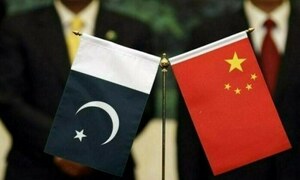Further decline in bilateral trade expected: rampant smuggling taking place under the guise of ATT: report
A rampant smuggling is taking place under the guise of Afghan Transit Trade (ATT) as large quantities of commodities are being imported by Afghanistan having limited domestic consumption or restricted demand by Afghan businessmen, showed a Pakistan Business Council (PBC) report.
The PBC report "selected trade and manufacturing data for Pakistan-a brief analysis- 2014" stated that with the deteriorating security situation in Afghanistan as international troops withdraw, further decline in bilateral trade is expected. A significant portion of trade between the two countries is informal and not captured in official statistics. While imports from Afghanistan increased by $73 million, bilateral trade declined by $28.7 million in 2013.
According to PCB report, about $39 million worth of special woven and tufted product, lace and tapestry were imported by the war-torn country in 2013. Similarly, 78 percent of the tea imported via ATT, worth $40.4 million was black tea in 2013. On the other hand, Pakistan's top five major imports from Afghanistan are edible fruits, nuts, peel of citrus fruit, melons and edible vegetables increased slightly whereas import of the cotton doubled in 2013.
The report said that contingent on a level-playing field, trade liberalisation leads to a stronger domestic manufacturing base which is not only competitive in the domestic market but also in regional and global arenas. It further states that Pakistani manufacturers have to contend with massive amounts of under-invoicing, misreporting and outright smuggling. According to the report, a comparison shows discrepancy in the reporting of trade data by two of Pakistan's trading partners namely China & India versus that reported by Pakistan. In the ease of imports in 2013, from China, there was a $3.38 billion difference in the value of goods reported as exported to Pakistan by China versus the figures reported by Pakistan Customs of imports from China.
The report examines the trade opportunities in the region and highlights the under-utilisation of SAFTA. Trade within the Saarc countries is compared with inter-regional trade among various regional economic zones. The Saarc region as a whole conducted world trade of more than $970 billion in 2013. Despite this, inter region trade consisted of only 3 percent of the total-much below other economic regions such as ASEAN, EU and MERCOSUR and the primarily reasons for this is the political hurdles to trade between two biggest economies of the region-India and Pakistan. If trade between the two countries is liberalised in a proper and equitable manner, it would result in a significant increase in trade volumes accompanied by economic and consumer benefits for both countries.
The report further states that conservative export potential of India for Pakistan is between 2-3 billion dollars. This is based on calculations assuming no non-tariff barriers.
Pakistan's export performance in the world market against countries with comparable bases is analysed. These countries are either catching up or going past Pakistan in the European Union market in particular and World trade in general. In the context of trade with the EU, the Study explains GSP+, the opportunities it offers, and the conditions that need to be met to retain it.




















Comments
Comments are closed.